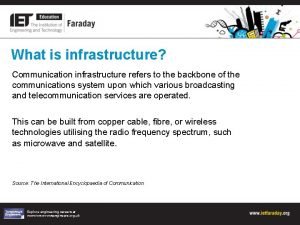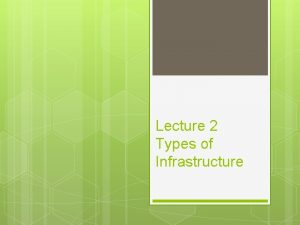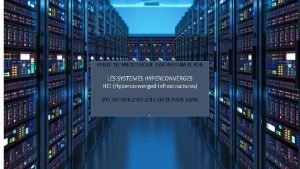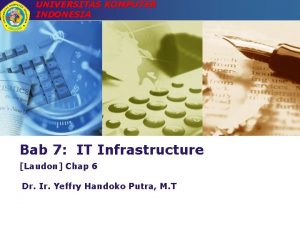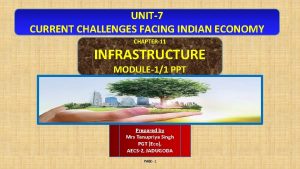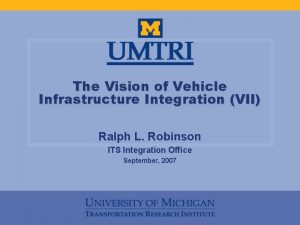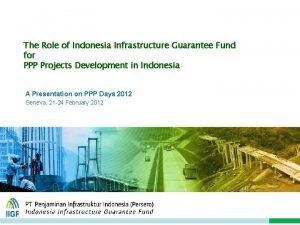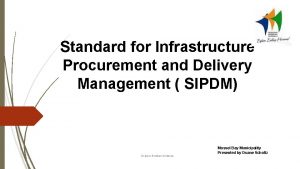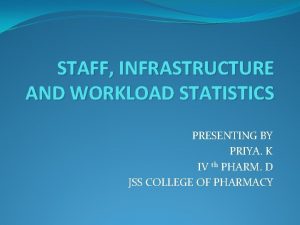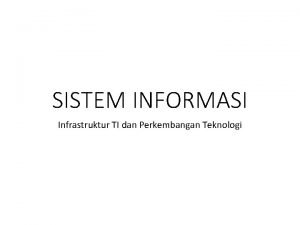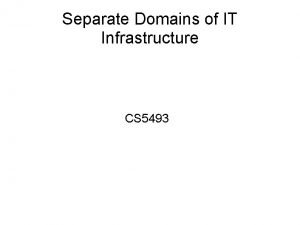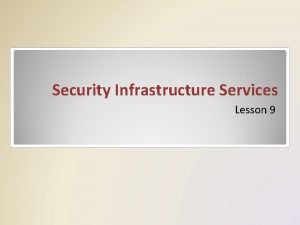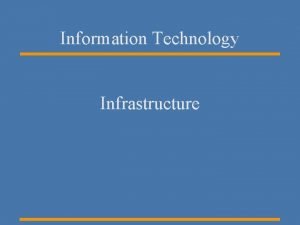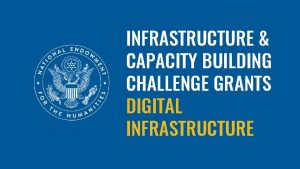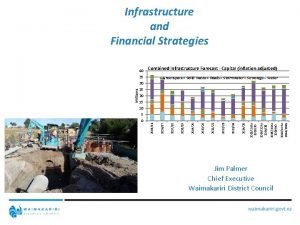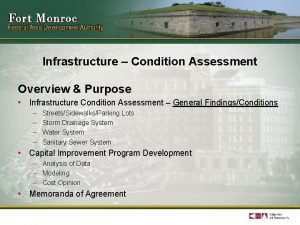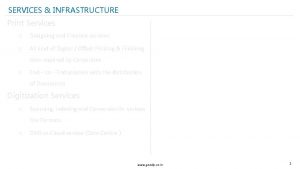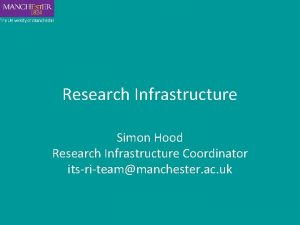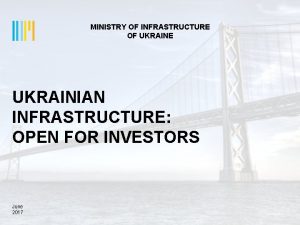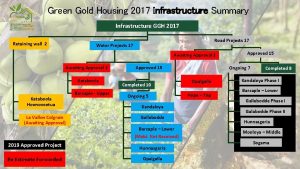Lecture 2 Types of Infrastructure TYPES OF INFRASTRUCTU


















- Slides: 18

Lecture 2 Types of Infrastructure

TYPES OF INFRASTRUCTU RE Hard Infrastructure Soft Infrastructure

Physical or Hard Infrastructure refers to the physical network that keeps an industrialized nation smoothly functional. Physical infrastructure can be broadly classified into transportation, water and sanitation, energy, telecommunication and waste management Hard Infrastructure fosters economic growth and physical development of the economy.

Transportation Infrastructure Transportation infrastructure is the fixed installation that allows a vehicle to operate; It consists of a way, a terminal and facilities for parking and maintenance. Road and highway networks including structures (bridges, tunnels, culverts, retaining walls), Signage and markings, electrical systems (Street lighting and traffic lights), edge treatments (curbs, sidewalks, landscaping), and specialized facilities such as road maintenance depots. Mass transits systems (Commuter rail systems, subways, tramways, trolleys, City Bicycle Sharing system, City Car Sharing system and bus transportation).


Railways, including structures, terminal facilities (rail yards, train stations), level crossings, signalling and communication systems. Canals and navigable waterways. Seaports and light houses. Airports, including air navigational systems. Bicycle paths and pedestrian walkways, including pedestrian bridges, pedestrian underpasses and other specialized structures for cyclists and pedestrians.

Energy Infrastructure Electrical power network, including generation plants, electrical grids, substations and local distribution. Natural gas pipelines, storage and distribution terminals, as well as the local distribution networks. Petroleum pipelines, including associated storage and distribution terminals. Specialized coal handling facilities, for washing, storing and transporting coal such as from coal mines.

Water Management Infrastructure Sustaining the collection and distributing systems, treatment plants and other infrastructure that collects treats and delivers water related services. Drinking water supply. Sewage collection and disposal of waste water. Drainage systems (storm sewers etc. ) Major irrigation systems (reservoirs, irrigation canals) Major flood control systems and Large-scale snow removal. Coastal Management.

Communication Infrastructure Postal Service Telephone networks including telephone exchange systems. Mobile phone networks Television and radio transmission stations Cable television physical networks Communication satellites Undersea Cables.

Solid Waste Management Municipal garbage and recyclables collection Solid waste landfills Solid waste incinerators and plasma gasification facilities Materials recovery facilities Hazardous waste disposal facilities

Soft Infrastructure The social infrastructure is the framework required to keep and maintain the different institutions which are necessary to sustain, economic, health, and cultural and social standards of a country, such as Financial System Education System Health care System of government and law enforcement Emergency services. It includes both physical assets such as highly specialized buildings and equipment used to maintain the institution.

Cont. . The non- physical assets such as The body of rules and regulations governing the various systems. The financing of these systems The organizational structure The software and programmes The systems and organizations by which highly skilled and specialized professionals are trained and are disciplined, if required, by professional associations (professional training, accreditation and discipline).

Cont. . Soft infrastructure facilitates human resource growth and development of good quality human resource. On a broader level, it means those basic activities and services which, in addition to achieving certain social objectives, indirectly help various economic activities. For example, education does not directly affect economic activities like production and distribution but indirectly helps in the economic development of the country by producing scientists, technologists and engineers.

Governance Infrastructure The system of government and law enforcement including the political, legislative, law enforcement, justice and penal systems as well as specialized facilities (government offices, courthouses, prisons etc. ), and specialized systems for collecting, storing and disseminating data, laws and regulation. Emergency services such as police fire protection, and ambulances, including specialized vehicles, buildings, communications and dispatching systems. Military infrastructure including military bases, arms depots, training facilities, command centre, communication facilities, major weapons systems, fortifications, specialized arm manufacturing and strategic reserves.

Economic Infrastructure The financial system, including the banking and financial institutions. Major business logistics facilities and systems, including warehouses as well as warehousing and shipping management systems. Manufacturing Infrastructure, including industrial parks and special economic zones, mines and processing plants for basic materials used as inputs in industry, specialized energy, transportation, and water infrastructure used by industry, plus the public safety, zoning, and environmental regulations that limit industrial activity, and standard organizations.

Agricultural, forestry and fisheries infrastructure, including specialized food , livestock transportation and storage facilities, major feedlots, agricultural price support system (including agricultural insurance), agricultural health standards, food inspection, experimental farms, and agricultural research centres and schools.

Social Infrastructure The health care System The educational and research system Social welfare systems, including both government support and private charity for the poor for people in distress or victims of abuse.

Cultural, Sports and Recreational Infrastructure Sports and recreational infrastructure, such as parks, sport facilities, the system of sports leagues and associations. Cultural Infrastructure, such as concert halls, museum, libraries, theatres, studios, and specialized training facilities. Business travel and tourism infrastructure, including both man-made and natural attractions, convention centres, hotels, restaurant, and other services that cater mainly to tourists and business travellers, as well as the system for informing and attracting tourists, and travel insurance
 01:640:244 lecture notes - lecture 15: plat, idah, farad
01:640:244 lecture notes - lecture 15: plat, idah, farad What is communication infrastructure
What is communication infrastructure Types of hard infrastructure
Types of hard infrastructure L'objectif de la lecture
L'objectif de la lecture Hamza halim
Hamza halim Ad hoc vs infrastructure
Ad hoc vs infrastructure Homeland security infrastructure program
Homeland security infrastructure program Définition hyperconvergence
Définition hyperconvergence It infrastructure ecosystem
It infrastructure ecosystem Three tier system of health infrastructure
Three tier system of health infrastructure Vehicle infrastructure integration
Vehicle infrastructure integration Indonesia infrastructure guarantee fund
Indonesia infrastructure guarantee fund Infrastructure procurement and delivery management
Infrastructure procurement and delivery management Workload statistics in hospital pharmacy slideshare
Workload statistics in hospital pharmacy slideshare Software quality infrastructure components
Software quality infrastructure components It infrastructure ecosystem
It infrastructure ecosystem Service mesh
Service mesh It infrastructure domains
It infrastructure domains It infrastructure skills matrix
It infrastructure skills matrix

